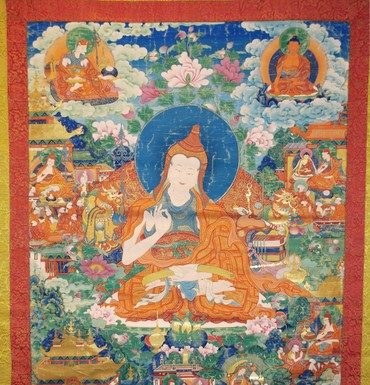Lamrim outline: Advanced

IV. How to guide students to enlightenment
- A. How to rely on spiritual teachers as the root of the path
B. Stages for training the mind
- 1. Being persuaded to take advantage of our precious human life
2. How to take advantage of our precious human life
- a. Training our minds in the stages in common with a person of initial motivation—striving for the happiness of future lives
b. Training our minds in the stages in common with a person of intermediate motivation—striving for liberation from cyclic existence
c. Training our minds in the stages of a person of higher motivation—striving for enlightenment for the benefit of all sentient beings
The path of the higher level practitioner
c. Training the mind on stages of the path when you are a person of higher level—striving for enlightenment for the benefit of all sentient beings
1) Advantages of the altruistic intention
a) It is the only gateway for entering the Mahayana path
b) One receives the name “child of the Buddha”
c) One will surpass in brilliance the sravakas and solitary realizers
d) One will become object of highest respect and offering
e) One will easily complete the collections of merit and insight
f) Obstacles and negative karma will be quickly eliminated
g) Whatever you wish for in general will happen
h) Altruism prevents and overcomes harm and interferences
i) One will quickly complete all the realizations of the path
j) One will become a source of comfort and happiness for all beings
2) The way to develop the altruistic intention
a) Actual stages of how to cultivate the altruistic intention
1′: Cultivating it through the seven points of cause and effect
a’: Recognizing that each sentient being has been one’s mother
b’: Remembering their kindness to you as your mother
c’: Wishing to reciprocate that kindness
d’: Heart-warming love—seeing others as lovable
e’: Great compassion
f’: Great determination
g’: Altruistic intention
2′: Cultivating it through equalizing and exchanging self and others
a’: Equalizing self and others
b’: Disadvantages of self-centeredness
c’: Advantages of cherishing others
d’: Exchanging self and others
e’: Giving your own happiness and taking the suffering of others
3′: Cultivating it through the eleven-point bodhicitta meditation
a’: Equanimity
b’: Recognizing all sentient beings have been your mother
c’: Remembering the kindness of others
d’: Wishing to reciprocate that kindness
e’: Equalizing self and others
f’: Disadvantages of self-centeredness
g’: Advantages of cherishing others
h’: Taking others’ suffering through compassion
i’: Giving away your own happiness through love
j’: Great determination
k’: Altruistic intention
b) How to take the bodhisattva vows
1′: Taking the bodhisattva vows if you haven’t taken them before
2′: Having taken vows, how to keep them pure and prevent degeneration
a’: Commitments of the aspiring bodhisattva vows
1. How to prevent the bodhicitta from degenerating this life
a. Remember the advantages of bodhicitta again and again
b. To strengthen one’s bodhicitta, generate the thought to attain enlightenment for the benefit of all sentient beings three times in the morning and three times in the evening. Recitation and contemplation of the prayer for taking refuge and generating the dedicated heart is a good way to fulfill this.
c. Do not give up working for sentient beings even when they are harmful
d. To enhance one’s bodhicitta, accumulate both merit and wisdom continuously
2. How to prevent losing the bodhicitta in future lives
a. Abandon the four black actions:
1] Deceiving the guru, abbot or other holy beings with lies
2] Causing others to regret virtuous actions that they have done
3] Abusing or criticizing bodhisattvas or the Mahayana
4] Not acting with a pure selfless wish but with pretension and deceit
b. Practice the four white actions:
1] Abandon deliberately deceiving and lying to gurus, abbots and so forth
2] Be straightforward, without pretension or deceit
3] Generate the recognition of bodhisattvas as one’s teacher and praise them
4] Assume the responsibility oneself to lead all sentient beings to enlightenment
b’: Commitments of the engaged bodhisattva vows (See Pearl of Wisdom, book II, or Aspiring and engaging bodhicitta
3) Having generated bodhicitta, how to engage in the bodhisattva’s deeds
a) How to accomplish the general conduct of all bodhisattvas
1′: Training in the six far-reaching attitudes to ripen your mind
a’: Generosity
1. Giving material aid
2. Giving protection from fear
3. Giving the Dharma
b’: Ethics
1. Ethics of restraining from acting destructively
2. Ethics of acting positively (gathering virtues)
3. Ethics of working for the benefit of others
c’: Patience
1. Patience of not retaliating
2. Patience of enduring difficulties
3. Patience of definitely practicing the Dharma
d’: Joyous effort
1. The three kinds of joyous effort
a. Armor-like joyous effort
b. Joyous effort of acting positively (gathering virtues)
c. Joyous effort of working for the benefit of others
2. The three kinds of laziness which interrupt joyous effort
a. Procrastination
b. Attraction to trivial matters and negative behavior
c. Discouragement, feelings of incapability
1. Two types of meditative stabilization according to their nature
a. Mundane
b. Transcendental
2. Three types of meditative stabilization according to their strength
a. Calm abiding meditation
b. Special insight meditation
c. Meditative stabilization which harmoniously combines the two
3. Three types of meditative stabilization according to their function
a. Meditative stabilization which cultivates mental and physical bliss
b. Meditative stabilization which brings all other advantages
c. Meditative stabilization enabling one to work for the benefit of others
f’: Wisdom
1. Wisdom understanding emptiness, ultimate truths
2. Wisdom understanding phenomena, conventional truths
3. Wisdom understanding how to benefit others
2′: Training in the four factors ripening the minds of others
a’: Being generous
b’: Speaking kindly and wisely, teaching the Dharma
c’: Giving encouragement
d’: Acting according to what one teaches, setting a good example
b) How to practice the last two far-reaching attitudes in particular
1′: Training in calm abiding to perfect meditative stabilization
a’: Arranging proper circumstances for calm abiding meditation
1. Live in a proper and conducive place
2. Have few desires and attachments
3. Be content
4. Avoid distractions and extraneous activities
5. Maintain pure ethical conduct
6. Abandon preconceptions about sense objects
b’: Actual way to practice calm abiding
1. Five deterrents to calm abiding
a. Laziness
b. Forgetting the object of meditation
c. Laxity and agitation
d. Not applying antidotes to the deterrents
e. Applying antidotes when they are not needed
2. Eight antidotes
a. Confidence or faith in the benefits of calm abiding
b. Aspiration
c. Joyous effort
d. Pliancy, serviceability of body and mind
e. Mindfulness
f. Introspective alertness
g. Application of appropriate antidotes
h. Equanimity
3. Nine stages in practicing calm abiding
a. Setting (placing) the mind
b. Continuous setting
c. Resetting
d. Close setting
e. Taming
f. Pacification
g. Thorough pacification
h. Single-pointedness
i. Setting in equipoise
4. Six mental powers to attain these stages
a. Hearing
b. Thinking
c. Mindfulness
d. Introspective alertness
e. Effort
f. Familiarity
5. Four engagements to employ to do this
a. Painstaking (forceful)
b. Repeated (interrupted)
c. Uninterrupted
d. Effortless (spontaneous)
2′: Training in special insight to perfect the wisdom of emptiness
a’: Establishing the selflessness of persons
1. Meditating on emptiness which is like space in sessions
a. Recognizing the object to be negated (refuted)
b. Argument conclusively refutes what is to be refuted
c. The I cannot exist singly or be the same as its parts
d. The I cannot exist as many or separate from its parts
2. In break times, contemplate things being like an illusion
b’: Establishing the selflessness of all phenomena
1. Being convinced that no functional phenomena truly exists
a. Form doesn’t truly (inherently) exist
b. Consciousness doesn’t truly exist
c. Non-associated compounded phenomena don’t truly exist
2. Being convinced that no permanent phenomena truly exist
c’: The way to develop actual special insight
(The eightfold noble path is often taught at this point)
c) How to practice the uncommon path of tantra
Venerable Thubten Chodron
Venerable Chodron emphasizes the practical application of Buddha’s teachings in our daily lives and is especially skilled at explaining them in ways easily understood and practiced by Westerners. She is well known for her warm, humorous, and lucid teachings. She was ordained as a Buddhist nun in 1977 by Kyabje Ling Rinpoche in Dharamsala, India, and in 1986 she received bhikshuni (full) ordination in Taiwan. Read her full bio.

